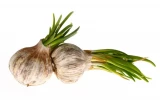11 Most Common Types of Garlic Plants (With Pictures)
Garlic is cultivated in various forms, with over 600 subspecies, including 11 common types distinguished by unique flavors, sizes, and growth conditions. These types range from the mild and versatile 'Softneck Garlic', which accounts for approximately 80% of the world's garlic production, to the robust and spicy 'Hardneck Garlic', known for its distinct flavor profiles and hard central stalk.
The most common types of garlic are usually categorized into two main groups: Softneck and Hardneck. Expanding the list, the most recognized types are:
- Silverskin
- Artichoke
- Creole
- Rocambole
- Porcelain
- Purple Stripe
- Marbled Purple Stripe
- Glazed Purple Stripe
- Turban
- Asiatic
- Elephant garlic
From the robust flavor of Hardneck varieties, cherished for their distinct tastes and scapes, to the versatile and storage-friendly Softneck types, commonly found braided in kitchens—lie gems like the mild yet sizable Elephant garlic, which isn't true garlic but a closer relative to leeks. But why is it listed here? Find out below.
Summary
- Softneck varieties are favored for their long-term storage capabilities and mild flavors, with Silverskin garlic being particularly noted for its ability to be braided. Artichoke garlic, characterized by its large bulb size and numerous cloves, thrives in warmer climates and offers a milder flavor.
- Hardneck garlic types are preferred for their strong flavors and the production of scapes. Rocambole garlic is known for its easy peeling and complex, spicy flavor. Porcelain garlic is recommended for those seeking garlic with a longer storage potential.
- Elephant garlic, though not a true garlic but closer to leeks, is included for its notably large size and milder flavor, making it a unique addition to the culinary world. Its gentle taste and impressive size make it a favorite among those seeking a less pungent garlic flavor in their dishes.
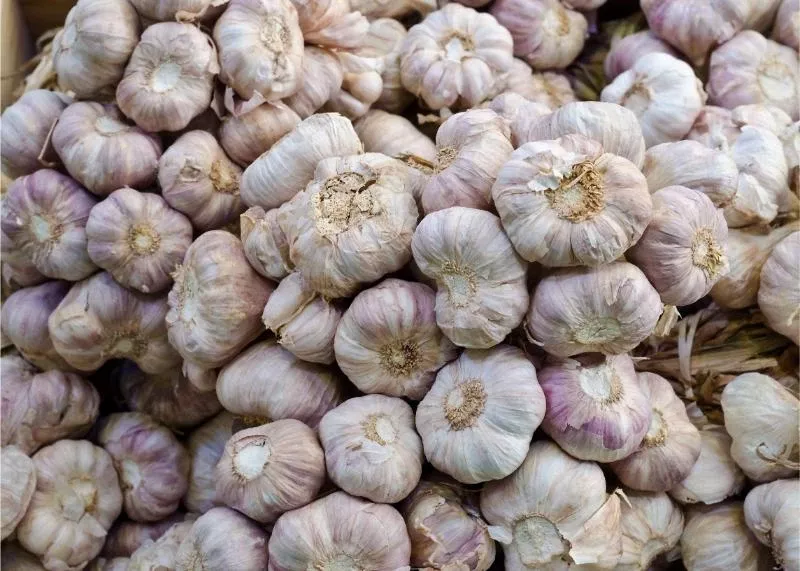
On this page:
3 Types of Softneck Garlic (Allium Sativum Ssp. Sativum)
Softneck garlic is favored for its mild flavor and ease of cultivation in warmer climates. Unlike its hardneck counterparts, it has a longer storage life, making it a common sight in grocery stores, and you can even braid the stems for decorative storage.
| Softneck Garlic Varieties | Distinct Characteristics |
|---|---|
| Silverskin garlic | Stores well and is often the kind found in supermarkets; has a fine, papery skin and a soft, pliable stalk that is easy to braid |
| Artichoke garlic | Named for the artichoke-like arrangement of cloves, this variety often has a milder flavor and is large in size |
| Creole garlic | Often grown in warmer climates where other types of garlic might not thrive as well; have a long storage life and a spicy flavor |
Silverskin garlic

Silverskin garlic, a type of softneck, is well-suited for long-term storage and is known for its ability to be braided. This garlic is recognized by its shiny, silvery white skin and generally contains many small cloves. Cloves are typically numerous and smaller than other types, which contributes to its prolonged shelf life.
You may find silverskin garlic as a staple in your local grocery stores due to its durability and subtle taste that won't overpower your dishes. Silverskin varieties like 'Nootka Rose' and 'Inchelium' are particularly well known.
Your Silverskin garlic will have a more pungent flavor compared to some other types, which makes it a favorite for cooking. When you're looking to store garlic for an extended period, this softneck variety excels, often lasting up to a year under proper conditions.
To keep your Silverskin garlic at its best, store it in a cool, dry place. This type also lends itself to decorative kitchen displays, as its flexible stems make it ideal for braiding. Whether you choose 'Nootka Rose' for its spicy edge or 'Inchelium' for its milder taste, you can count on Silverskin garlic to enhance your dishes with its robust flavor.
Artichoke garlic

Artichoke garlic, contrary to what the name might suggest, is not related to the globe artichoke. It is, in fact, a type of softneck garlic characterized by its numerous clove layers that resemble the overlapping petals of an artichoke flower. Artichoke garlic bulbs tend to be large with multiple cloves, sometimes more than a dozen.
- Flavor: Mild, less intense than other varieties
- Clove arrangement: Overlapping layers like an artichoke
- Growing conditions: Adapts well, large bulb potential
- Shelf life: Quite long, thanks to thick outer skin
Artichoke garlic thrives in warmer climates and offers a milder flavor compared to other garlic types. Its ability to maintain quality over a long period makes Artichoke garlic both a gardener's and cook's friend. Your garden will thrive with this garlic variety due to its easy-to-grow nature and robustness.
Creole garlic
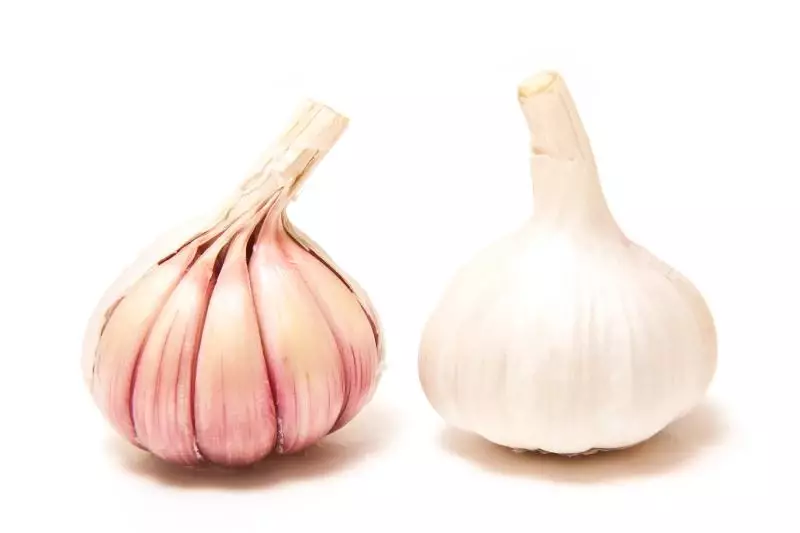
Creole garlic is a delightful variety for you to consider if you're looking to add a milder flavor to your dishes. This type of garlic is recognized for its colorful cloves which can range from rose to purple, depending on the specific variant. You'll find Creole Red, for instance, distinguished by its white bulb wrappers and 6-8 dark red cloves.
Most Creole garlic varieties share a complex, yet not overpowering flavor profile. They tend to be less pungent than other types when eaten raw, making them a great choice for your fresh salsas or pestos. You might particularly enjoy their taste when they are incorporated into dishes that don't require cooking, as their mildness comes through beautifully.
Your garden might also benefit from growing Creole garlic due to its adaptability to warmer climates. It's an excellent option if you're in an area with mild winters, as this garlic thrives in such conditions.
When you're selecting garlic for planting, keep in mind that Creole garlic can offer both a pleasant culinary experience and a beautiful addition to your garden with its large, attractive bulbs.
Where is the best place to plant garlic? Is it in a sunny or a shady location? Find out here.
7 Types of Hardneck Garlic (Allium Sativum Ssp. Ophioscorodon)
Hardneck garlic varieties are known for their robust flavor and are well-suited to colder climates. They produce a flowering stem called a scape, which is often removed to encourage larger bulb growth. Here's a glimpse into some popular types of hardneck garlic.
| Hardneck Garlic Varieties | Distinct Characteristics |
|---|---|
| Rocambole garlic | Known for their rich, complex flavor and are often a favorite of chefs and garlic connoisseurs; have a hard central stalk and their cloves are usually easy to peel |
| Porcelain garlic | Have a thick, durable skin which makes them good for storing; typically have a strong, spicy flavor and fewer, but larger, cloves |
| Purple Stripe garlic | Have a distinctive purple striping on the bulb wrappers; known for their sweet, complex flavor when cooked |
| Marbled Purple Stripe garlic | A subtype of purple stripe with marbled, streaky bulb wrappers and a strong flavor |
| Glazed Purple Stripe garlic | Another subtype of purple stripe, these have a shiny, glazed appearance and are similar in flavor to other purple stripe varieties |
| Turban garlic | Known for its early harvest time and a wide range of flavors, from mild to very spicy; bulbs usually have an attractive turban-like shape |
| Asiatic garlic | Matures early and has a strong, spicy flavor; often have fewer cloves per bulb |
Rocambole garlic
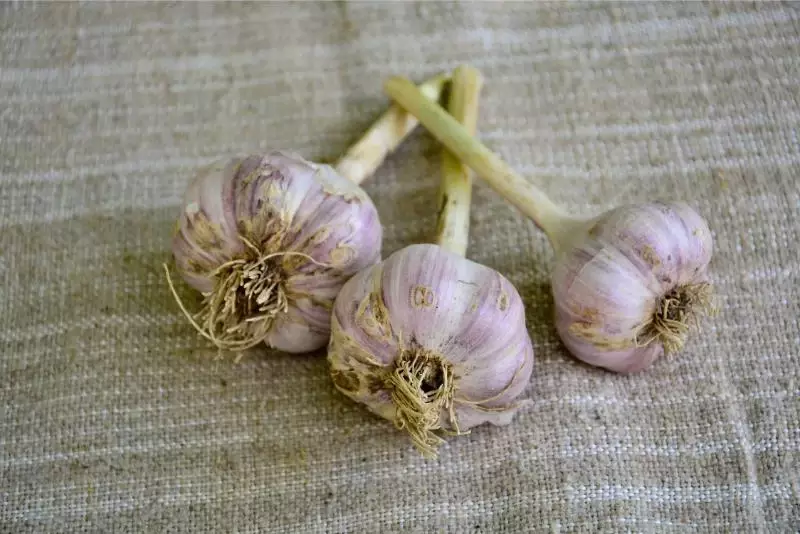
Rocambole garlic is cherished for its complex, spicy flavor and ease of peeling. They typically have a shorter shelf life due to their loose skin, so you'll want to use them relatively quickly. Rocamboles thrive in areas with cold winters and have a curled stalk or scape that's quite delicious when cooked.
- Flavor profile: Strong, complex taste
- Clove count: About 8-12 large cloves per bulb
- Planting: Plant in well-drained soil, 6 inches apart
You'll appreciate its heirloom varieties, such as the well-known German Red variety, which is a subtype of Rocambole garlic known for its spicy flavor.
- Heirloom subtype: German Red
- Growing season: Plant in fall for a summer harvest
- Care tips: Mulch well to protect over winter
Rocambole garlic can be identified by its rather loose skin, which makes it easier to peel. However, this trait also shortens its shelf life, so it's best used relatively quickly after harvest.
- Peeling: Loose skin, easy to peel
- Shelf life: Shorter, use within a few months
- Storage: Cool, dry place away from sunlight
Porcelain garlic
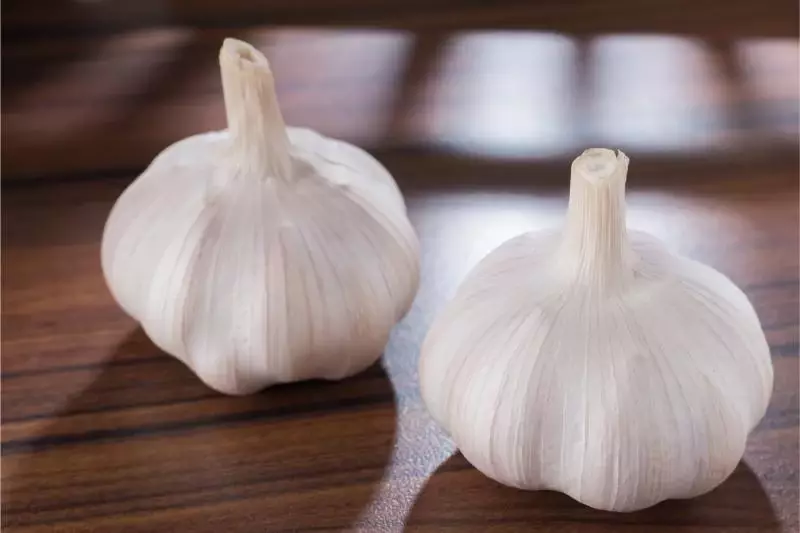
With their large, plump bulbs and thick, paper-like wrappers, Porcelain garlic varieties such as 'Music' and 'Georgian Crystal' are exceptionally hardy. You'll plant them in the fall and enjoy their strong and robust flavor. Their long stalks make storage a breeze, contributing to an impressive shelf life.
Porcelain garlic is a hardneck variety that stands out for its large, attractive bulbs. You'll appreciate the generous size of the cloves, which make them easier to peel. This garlic type, including popular varieties like German White, and Siberian, is known for a rich, moderately spicy flavor that enhances your culinary creations.
Each bulb of porcelain garlic typically contains about four to seven hefty cloves. You'll find the bulbs are encased in a thick, papery skin, giving them a longer shelf life compared to some other garlic types. If you're aiming to grow garlic that stores well, porcelain varieties should be on your list.
- Type: Hardneck
- Flavor: Rich, moderately spicy
- Clove count: 4-7 per bulb
- Storage: Long shelf life
Aside from porcelain garlic, here's a list of the other lucrative garlic varieties.
Purple Stripe garlic
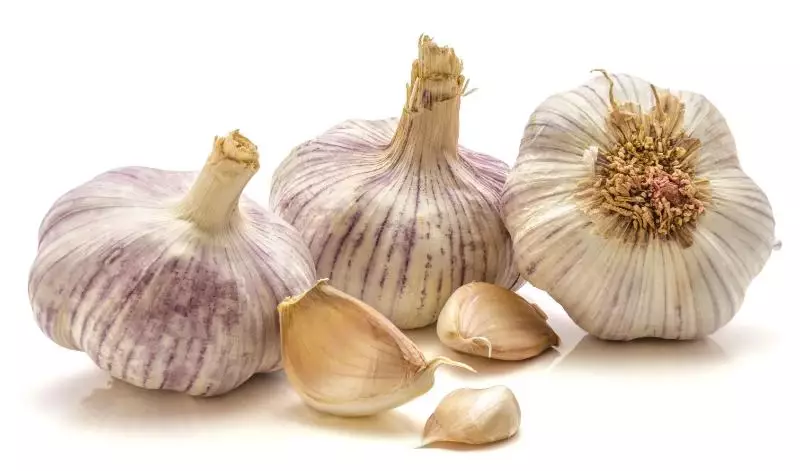
The Purple Stripe garlic, identifiable by its striking bulb coloration, offers a balance between robustness and a milder taste profile. They're suited for hearty meals where you seek an underlying garlic flavor without overwhelming your palate. Harvest them in spring for peak flavor and quality.
Purple Stripe garlics are a favorite among culinary enthusiasts and gardeners for their vibrant purple stripes and hardiness in different climates.
Marbled Purple Stripe garlic
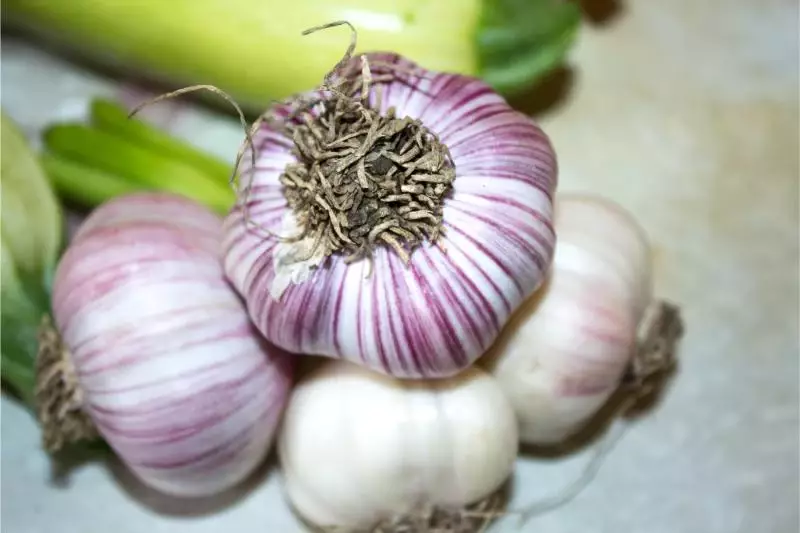
Marbled Purple Stripe garlic, such as the 'Bogatyr' variety, tends to have a strong and complex flavor profile that enhances your dishes. Its bulbs are large, with about 4 to 7 cloves each, which are wrapped in thick, purple-blotched skins.
Glazed Purple Stripe garlic

The 'Glazed Purple Stripe' garlic is named for its shiny, glazed appearance. You'll find this type to have fewer cloves, usually around 4 to 10, that are easy to peel. Try the 'Rose de Lautrec' for a French gourmet experience known for its rich, slightly sweet flavor.
Turban garlic
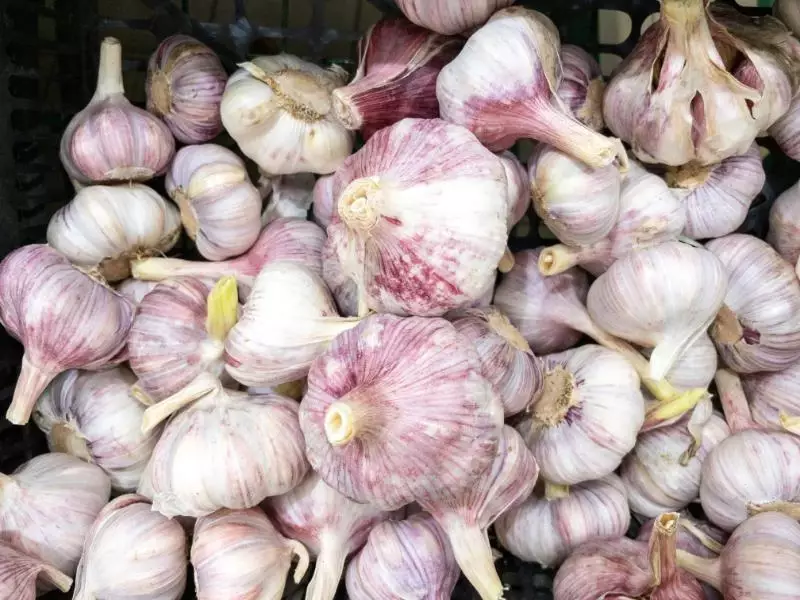
Turban garlic is notable for being one of the earliest hardneck varieties to be ready for harvest. Their name comes from the turban-like shape of their cloves. Quick to bolt in the spring, they offer a spicy yet warm flavor profile that's great for a variety of dishes.
Turban garlic is known for its distinct qualities and early harvest time. Contrary to other types of garlic which are generally harvested in summer, your Turban garlic can be ready to harvest in late spring or early summer. This trait allows for a swift and rewarding start to your garlic season.
- Type: Hardneck
- Flavor: Mildly spicy, strong, yet balanced
- Cloves per bulb: Usually 8-12
- Storage: Good; approximately 7 months
The bulbs exhibit an attractive appearance, often showcasing a vibrant purple striping. When you collect your Turban garlic, you'll notice the bulbs have large, easy-to-peel cloves. This makes them not only a visually appealing variety but also very practical for culinary uses.
In terms of flavor, Turban garlic is quite flavorful. It imparts a rich, full-bodied taste to dishes, making it a favorite for adding depth to your recipes. As a bonus, if you're sensitive to the strong bite of garlic, you might appreciate the Turban variety's generally milder temperament.
- Planting: Plant in the fall, 1-2 inches deep
- Soil: Well-drained, fertile soil
- Water: Regular watering, but do not overwater
Your Turban garlic should be stored in a cool, dry place once harvested to maintain its quality.
Asiatic garlic

Asiatic garlic can surprise you with its broad range of flavors, from mild to strong. They're typically earlier to mature than other hardneck types and are known for their unique bulbil formation at the top of the scape. Asiatic varieties epitomize the hardneck capacity to adapt and thrive in diverse conditions.
Asiatic garlic is a distinctive variety that matures early in the season. You might enjoy its strong, spicy flavor, which adds a robust kick to your dishes. This type of garlic is known for its large white bulbs and typically contains 5-7 plump cloves.
The cloves should be planted in a well-drained soil. During its growth, Asiatic garlic produces broad leaves and bulbils that form mid-stem. Since the bulbs can overmature and open up during curing, you'll want to pay special attention near harvest time.
One of the well-known cultivars of Asiatic garlic is the Korean Red. It is favored for its hot, spicy taste which is perfect if you're looking to bring some heat to your cooking.
How long does garlic take to grow? Find out here.
Elephant Garlic (Allium Ampeloprasum)
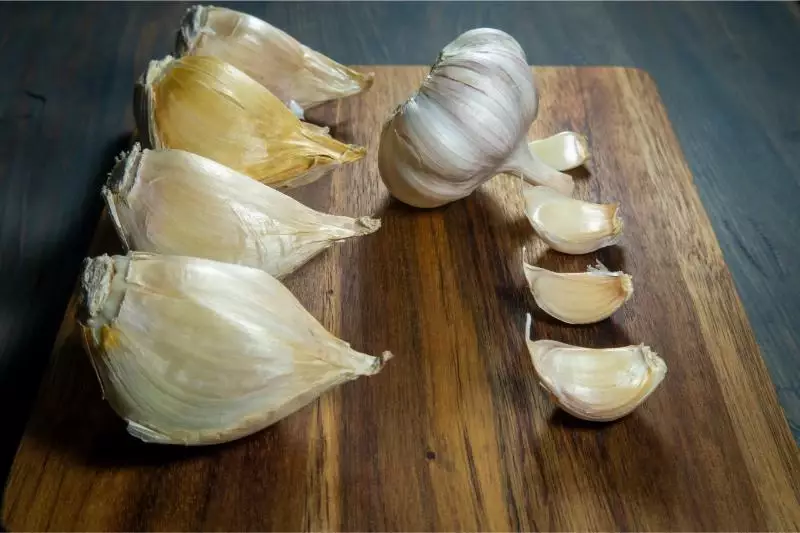
Elephant garlic is not your usual garlic. You'll note its considerably large size, which earns it the "elephant" moniker. Although often considered a type of garlic due to its large cloves and similar appearance, it's actually much closer to leeks in terms of genetics.
When you cook with elephant garlic, you'll notice its mild flavor compared to the more intense taste of traditional garlic.
- Size: The bulb size is notably larger than that of the common garlic varieties.
- Flavor: It boasts a gentler, less pungent taste.
- Related to: More akin to leeks than to garlic.
Culinary enthusiasts often favor elephant garlic when a more subdued garlic presence is desired in a dish. Its large bulbs make it a stand-out addition to your garden, and it can be an exciting conversation starter in your kitchen due to its impressive size.
Growing tips
- Sunlight: Prefers sunny locations.
- Soil: Thrives in well-drained soil.



